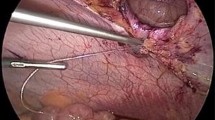Abstract
Background
This study reports medium-term outcomes of laparoscopic incisional hernia repair.
Study Design
Laparoscopic repair was performed on 721 patients with ventral hernia. After adhesiolysis the defect was closed with no. 1 polyamide suture or loop. This was followed by reinforcement with intraperitoneal onlay repair with a bilayered mesh.
Results
Laproscopic repair of ventral hernia was performed on 613 females and 108 males. Of these, 185 (25.7%) were recurrent incisional hernias of which 93 had undergone previous open hernioplasty. The remaining 92 patients had previously undergone sutured repair. The average operating time was 95 min (range 60–115 min). Conversion rate was 1%. The average hospital stay was 2 days (range 1–6 days). The commonest complication was seroma formation at the incisional hernia site. Full-thickness bowel injury occurred in two patients. The mean follow-up period was 4.2 years (range 3 months to 10 years). Recurrence was noted in four (0.55%) patients.
Conclusion
Laparoscopic repair is well-tolerated and can be accomplished with minimum morbidity in ventral hernias.




Similar content being viewed by others
References
Read RC, Yoder G (1989) Recent trends in the management of incisional herniation. Arch Surg 124(4):485–488
Anthony T, Bergen PC, Kim LT et al (2000) Factors affecting recurrence following incisional herniorrhaphy. World J Surg 24(1):95–100
Luijendijk RW, Lemmen MH, Hop WC et al (1997) Incisional hernia recurrence following “vest-over-pants” or vertical Mayo repair of primary hernias of the midline. World J Surg 21(1):62–65
Liakakos T, Karanikas I, Panagiotidis H et al (1994) Use of Marlex mesh in the repair of recurrent incisional hernia. Br J Surg 81(2):248–249
Luijendijk RW, Hop WC, van den Tol MP et al (2000) A comparison of suture repair with mesh repair for incisional hernia. N Engl J Med 343:392–398
Leber GE, Garb JL, Alexander AI et al (1998) Long-term complications associated with prosthetic repair of incisional hernias. Arch Surg 133(4):378–382
White TJ, Santos MC, Thompson JS (1998) Factors affecting wound complications in repair of incisional hernias. Am Surg 64(3):276–280
LeBlanc KA, Booth WV (1993) Laparoscopic repair of incisional abdominal hernias using expanded polytetrafluoroethylene: preliminary findings. Surg Laparosc Endosc 3:39–41
Cobb WS, Kercher KW, Heniford BT (2005) Laparoscopic repair of incisional hernias. Surg Clin N Am 85(1):91–103
Jani K, Palanivelu C, Parthasarathi R, et al. Laparoscopic repair of paracolostomy hernia: secure reinforced closure of the defect prevents recurrence. Accepted for publication. J Laparoendosc Adv Surg Tech A
Palanivelu C, Rangarajan M, Senthilkumar R et al. Laparoscopic management of drain site incisional hernias following laparotomies—a simple suture technique. Accepted for publication. J Laparoendosc Adv Surg Tech A
Franklin ME, Gonzalez JJ, Glass JL et al (2004) Laparoscopic ventral and incisional hernia repair: an 11-year experience. Hernia 8(1):23–27
Heniford BT, Park A, Ramshaw BJ et al (2003) Laparoscopic repair of ventral hernias: nine years’ experience with 850 consecutive hernias (discussion:399–400). Ann Surg 238(3):391–399
Carbajo MA, Martin del Olmo JC et al (1999) Laparoscopic treatment vs open surgery in the solution of major incisional and abdominal wall hernias with mesh. Surg Endosc 13(3):250–252
DeMaria EJ, Moss JM, Sugerman HJ (2000) Laparoscopic intraperitoneal poly-tetrafluoroethylene (PTFE) prosthetic patch repair of ventral hernia. Prospective comparison to open prefascial polypropylene mesh repair. Surg Endosc 14(4):326–329
Ott V, Groebli Y, Schneider R (2005) Late intestinal fistula formation after incisional hernia using intraperitoneal mesh. Hernia 9(1):103–104
Basoglu M, Yildirgan MI, Yilmaz I et al (2004) Late complications of incisional hernias following prosthetic mesh repair. Acta Chir Belg 104(4):425–428
Costa D, Tomas A, Lacueva J et al (2004) Late enterocutaneous fistula as a complication after umbilical hernioplasty. Hernia 8(3):271–272
Losanoff JE, Richman BW, Jones JW (2002) Entero-colocutaneous fistula: a late consequence of polypropylene mesh abdominal wall repair: case report and review of the literature. Hernia 6(3):144–147
LeBlanc KA, Whitaker JM, Bellanger DE et al (2003) Laparoscopic incisional and ventral hernioplasty: lessons learned from 200 patients. Hernia 7(3):118–124
Ujiki MB, Weinberger J, Varghese TK et al (2004) One hundred consecutive laparoscopic ventral hernia repairs. Am J Surg 188(5):593–597
Moreno-Egea A, Torralba JA, Girela E et al (2004) Immediate, early, and late morbidity with laparoscopic ventral hernia repair and tolerance to composite mesh. Surg Laparosc Endosc Percutan Tech 14(3):130–135
Toy FK, Bailey RW, Carey S et al (1998) Multicenter prospective study of laparoscopic ventral hernioplasty: preliminary results. Surg Endosc 12:955–959
Ramshaw BJ, Esartia P, Schwab J et al (1999) Comparison of laparoscopic and open ventral herniorrhaphy. Am Surg 65:827–832
Voeller GR (2001) Repair of incisional hernias and midline defects. In: Bendavid R, Abrahamson J, Arregui ME, Flament JB, Phillips EH (eds) Abdominal wall hernias: principles and management. Springer, New York, pp 519–524
Cassar K, Munro A (2002) Surgical treatment of incisional hernia. Br J Surg 89:534–545
Joels CS, Matthews BD, Austin CE et al (2004) Evaluation of fixation strength and adhesion formation after ePTFE mesh placement with various fixation devices. Presented at SAGES Scientific Session. Denver, Colorado
van’t Riet M, de Vos van Steenwijk PJ, Kleinrensink GJ et al (2002) Tensile strength of mesh fixation methods in laparoscopic incisional hernia repair. Surg Endosc 16(12):1713–1716
Bower CE, Reade CC, Kirby LW et al (2004) Complications of laparoscopic incisional ventral hernia repair: the experience of a single institution. Surg Endosc 18(4):672–675
Author information
Authors and Affiliations
Corresponding author
Rights and permissions
About this article
Cite this article
Palanivelu, C., Jani, K.V., Senthilnathan, P. et al. Laparoscopic sutured closure with mesh reinforcement of incisional hernias. Hernia 11, 223–228 (2007). https://doi.org/10.1007/s10029-007-0200-0
Received:
Accepted:
Published:
Issue Date:
DOI: https://doi.org/10.1007/s10029-007-0200-0




